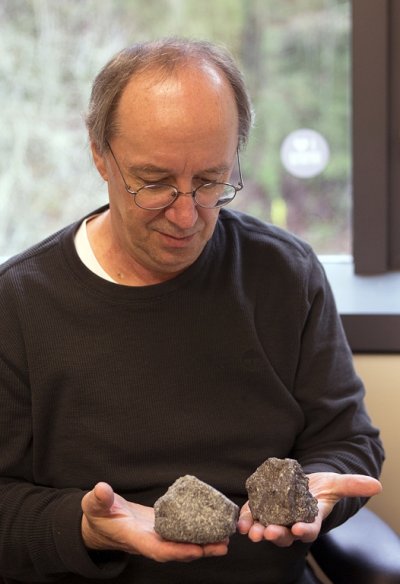Snowder collects dirt from far-flung locales
Brad Snowder’s focus is on the stars – he teaches astronomy at Western Washington University and Whatcom Community College, he is the director of Western’s planetarium and he delivered updates about the landing of the Mars rover via social media outlets.
For a man whose eyes are on the skies, it seems contradictory that he would collect dirt.
"I call them 'components' because it’s not just dirt," Snowder says. "It started out as dirt, but now it’s anything that can fit into a bottle – any sort of material component. They’re little mementos."
When Snowder was about 5 years old, his family went on a trip to Oklahoma. His parents told him about a place where the dirt was red – very red. Once they arrived, Snowder saw that it was clay, and just how red it was. He scooped some up and took it home with him.
From then on, when his family traveled, they would collect dirt from every state. That collection is long lost now, but it inspired him to do the same when he went to Europe in August and September of 2000.
Snowder brought both digital and film cameras with him, but the day he arrived he dropped the digital camera, breaking it. He took film photos the rest of the trip. Because of this, he had plenty of empty film canisters, so every now and then he would take one of the canisters out and scoop up some dirt, rocks or other things.
“The GPS was kind of new. I had a little GPS that had a function where you could drop ‘breadcrumbs,’ so later I could go back and look at the latitude and longitude of where I picked up the different components,” Snowder said.
When recollecting his favorite component, the storyteller inside of Snowder came out.
“It’s much better when you have a story to go with it,” Snowder said.
He collected one component in Kilkenny, Ireland. In the 1300s, a woman and her maid were accused of witchcraft there. She had several husbands die in a row mysteriously, and she was accused of casting spells on her husband. The woman escaped and was never heard from again, but her maid was burned at the stake and is buried in the shadow of the old monastery tower that the city is built around, Snowder recounted.
Snowder’s friends also have contributed to his collection, bringing him soil from a garden built by Constantine in Istanbul, Turkey; volcanic ash from The House of Venus in Pompeii, Italy, which was buried by the eruption of Mt. Vesuvius; pieces of marble from the ruins of the Temple of Athena from Acropolis, Greece; and canal water from Venice, Italy.
Snowder said that if he had more time and money to travel, it would be fun to collect dirt from places on every continent.
“And I’d need some moon dust, of course,” Snowder said.
